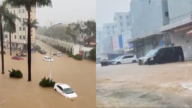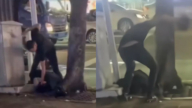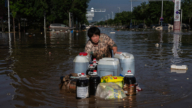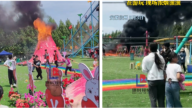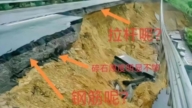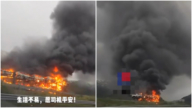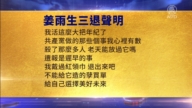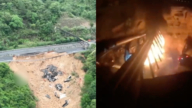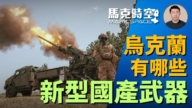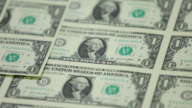【新唐人2013年11月01日讯】备受海外媒体关注,并震惊中南海的“北京天安门汽车爆炸”事件,虽然因疑点重重而遭到各方质疑,但仍被当局定性为“暴力恐怖袭击事件”。自中共执政以来,天安门前抗议、流血事件频发,无论大小,最终都躲不过“暴乱”、“反动”的罪名。虽然天安门前的维稳手段不断升级,但涌向天安门广场的抗议者却越来越多,抗议的方式也越加激烈,使得当局每年数千亿维稳经费的投入,成了赤裸裸的讽刺。
10月30号,北京警方就28号发生的天安门汽车爆炸事件,公布调查结果。警方说:“10•28”事件是一起由维族人“经过严密策划,有组织、有预谋的暴力恐怖袭击案件”,5名“在逃涉案人员”已经全部被抓获。
由于中共当局在爆炸发生的第一时间封锁了现场,甚至扣押了现场的外媒记者,又在事发后严控传媒和网路,命令网警查禁了一切相关消息,使得海外媒体虽然对于此案极为关注,但由于了解的信息有限而无法确认事件的真相。
“中国冤民大同盟”美国总部主持者葛丽芳:“为什么封锁那么严密,肯定里面有对共产党不利的信息了。因为共产党现在这种残忍,已经引起每个被所谓人民政府镇压的或者迫害的这些人民个个都痛恨。它生怕再有更大的事情发生,而且它又要召开三中全会了。”
但各大国际媒体普遍认为,北京天安门已经成为民众表达诉求的重要场所,尽管中共投入了巨额维稳经费并采用了无所不用其极的维稳措施,但仍然无法保证天安门的安全。
不同于其他国家的标志性建筑,北京天安门自1949年中共建政以来,已经被赋予了“政治”色彩。从1989年的“6.4”学生运动,到1999年的“4.25”法轮功万人和平请愿,再到近十年来前仆后继涌向天安门抗议的访民,都无一例外的遭到了中共当局的血腥暴力镇压。天安门广场也从此成为中共最为敏感的一根神经。
这里不仅没有供人休息的座椅、遮荫的树木或凉亭,甚至连一座公厕都没有。取而代之的是遍地的便衣、随时检查过往车辆和行人的警察,以及隐蔽在各个角落的摄像头,和四处竖起的栅栏…… 维稳已经成为了中共执政的重中之重。
葛丽芳:“它越是这样维稳,就像一个皮球一样,它越是这样把它压下去,越是弹的更厉害。肯定它一直这样拖,不解决问题,任何维稳是没有作用的,其实根本都是徒劳,而且浪费国家的资源。”
中国社科院2013年的《社会蓝皮书》指出,近年来大陆群体事件,已经由每年的几万起发展到每年十多万起。据北京“清华大学”学者孙立平估计,2010年中共的维稳支出金额为5490亿元人民币,“群众抗议事件”却超过18万宗;另一项由中共财政部公布的财政预算显示,2012年大陆“公共安全”支出达到了7000亿以上。但访民依然滚雪球般的增加。
前往北京天安门的访民逐年递增,高峰时,每天会有数百访民在天安门附近被抓。民众抗议的方式也越来越激烈,从拉横幅、撒传单、裸奔、放鞭炮、举牌等,发展到自残甚至自杀。例如,武汉、内蒙、北京访民跳天安门城楼;湖南、陕西访民自焚;山东、上海、东北访民跳金水河自杀等。悲剧不断在天安门上演,有外媒因此将天安门形容为“绝望者的舞台”。
维权人士悲叹,长期以来,面对访民们走投无路的各种申冤诉求方式,中共却在不断“完善”着针对访民们的维稳手段,每一次民众抗议的升级,换来的是更加严厉的维稳打压,而民众提出的实际问题,却从不在考虑之列,如此维“稳”,社会怎能稳定?
采访编辑/张天宇 后制/周天
More Maintaining Stability In Tiananmen
Makes It Less Stable
Tiananmen deadly crash shocked the Zhongnanhai high-level,
officials.
Although many doubtful points were questioned by the public,
the regime still classified it as “a violent terrorist attack".
Since the Chinese Communist Party (CCP) ruled China,
protests and major incidents often happened at Tiananmen.
No matter large or small the regime always
labeled it as a “riot" or “reactionary force".
Although maintaining stability measures for Tiananmen
constantly escalated, the protesters are still increasing, and
the ways of protests are more fierce.
The regime spends vast sums on maintaining stability that
has become a stark irony.
On Oct. 30, Beijing police announced investigation results
for the incident that took place on Oct. 28.
The police said the incident was “a violent terrorist attack
carefully planned, organized and premeditated" by Uighurs.
Police arrested five suspects connected to the incident.
The incident spot was immediately blocked, several foreign
journalists were temporary arrested on the site.
The internet was strictly controlled; all related news censored.
Although foreign media were very concerned about the
incident, they lacked truthful information.
Ge Lifang, US-based spokeswoman of China Alliance for
Victims of Injustice: “Why is the information so censored?
It certainly is something bad for the Chinese Communist
Party (CCP).
Because the CCP is so cruel, it has aroused every one’s
anger, from those who have been suppressed and persecuted.
The CCP fears that greater incidents will happen,
yet the Third Plenary Session opens soon."
Global mainstream media generally believe that Tiananmen
has become an important site for peoples’ injustice to be heard.
Although the CCP has spent huge sums on maintaining stability,
implementing all means of safeguards, it still cannot guarantee
the safety of Tiananmen.
Different to other country landmarks, since the CCP ruled
China from 1949 Tiananmen is covered by political atmosphere.
The Tianamen Students Protest on June 4, 1989, to Falun Gong’s
peaceful protest on April 25, 1999,
Over the past decade, petitioners repeatedly protested in
Tiananmen, all of them were violently suppressed.
Tiananmen Square became the CCP’s most sensitive nerve.
Not only are there no seats, trees or pagodas for tourists to rest,
there are no public toilets.
Instead plainclothes police are everywhere checking people
and vehicles at any time.
CCTV cameras are installed everywhere, Fences were put up.
Maintaining stability has become a top priority of the regime.
Ge Lifang: “The CCP’s maintaining stability is like bouncing
a ball, the more pressing down on it, the higher it jumps.
The regime always postponed situations like this,
never trying to solve the problem.
Maintaining stability is useless, wasting China’s resources."
The 2013 Blue Book of Chinese Society issued by Chinese
Academy of Social Sciences says the mass protests in
Mainland China have increased from a few thousand to
hundreds of thousands each year.
Sun Liping, scholar of Tsinghua University says, the cost of
maintaining stability in 2012 was 549 billion yuan.
Mass protests exceeded 180,000.
Financial Ministry’s budgets shows, in 2012, 700 billion
yuan was spent on “public security".
However, petitioners’ numbers have snow balled.
Petitioners going to Beijing is increasing yearly. At peak
times, several hundred were arrested near Tiananmen daily.
The kinds of protests have become more and more intense.
From unfolding banners, scattered fliers, naked runs,
and setting off fireworks, to committing suicide.
For example, petitioners from Wuhan, Inner Mongolian and
Beijing jumped off Tiananmen building.
Petitioners from Hunan and Shanxi set themselves on fire.
Petitioners from Shandong, Shanghai and North-East jump
to the river committed suicide.
Tragedies are repeatedly happening at Tiananmen Square.
Now foreign media call Tiananmen a “desperate stage".
Activists say that for the long term, facing desperate
petitioners’ various ways of petitioning, the CCP constantly
“improves" methods of maintaining stability to deal with them.
Each intensified protest results in a worse suppression.
The real problems that petitioners raised
are not considered by the CCP.
Can society be stablised by maintaining “stability?"


